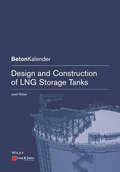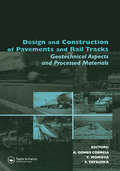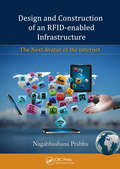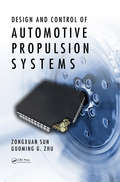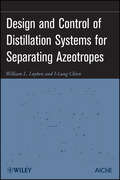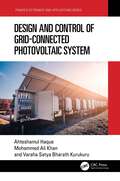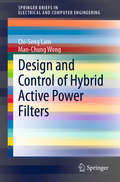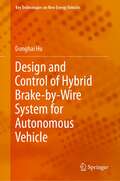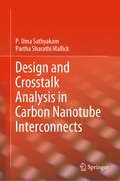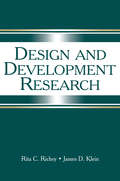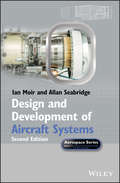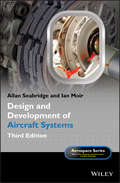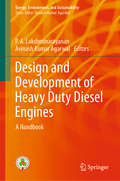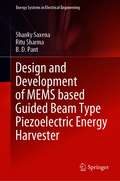- Table View
- List View
Design and Construction of Concrete Floors
by George GarberDesign and Construction of Concrete Floors recognizes that a good floor must do far more than support its intended loads. This thoroughly updated third edition provides further insight into polished concrete, limestone cement, and jointless floors for an international audience of structural engineers, architects, and building developers. This book discusses structural design, crack control, flatness, wear resistance, slip resistance, and suitability for floor coverings.This book provides detail on different concrete floor types, including ground-supported concrete floors; suspended concrete floors; office and residential floors; institutional floors, including those in hospitals and libraries; industrial floors, including those that support robotic equipment; floors over contaminated soil; superflat floors; and polished concrete. In addition, this book expands on designing floors for sustainability and reduced carbon footprint.
Design and Construction of LNG Storage Tanks (Beton-Kalender Series)
by Josef RötzerWorldwide, the use of natural gas as a primary energy source will remain vital for decades to come. This applies to industrialized, emerging countries and developing countries. Owing to the low level of impurities, natural gas is considered to be a climate-friendly fossil fuel because of the low CO2 emissions, but is at the same time an affordable source of energy. In order to enable transport over long distances and oceans (and hence create an economic and political alternative to pipelines) , the gas is liquefied, which is accompanied by a considerable reduction in volume, and then transported by ship. Thus, at international ports, many LNG tanks are required for temporary storage and further use. The trend towards smaller liquefaction and regasification plants with associated storage tanks for marine fuel applications has attracted new players in this market who often do not yet have the necessary experience and technical expertise. It is not sufficient to refer to all existing technical standards when defining consistent state-of-the-art specifications and requirements. The switch to European standardisation has made it necessary to revise and adapt existing national codes to match European standards. Technical committees at national and international level have begun their work of updating and completing the EN 14620 series. In the USA, too, the corresponding regulations are also being updated. The revision of American Concrete Institute standard ACI 376 Requirements for Design and Construction of Concrete Structures for the Containment of Refrigerated Liquefied Gases, first published in 2011, will be completed in the spring of 2019, and the final version, published in autumn 2019. This book provides an overview of the state of the art in the design and construction of liquefied natural gas (LNG) tanks. Since the topic is very extensive and complex, an introduction to all aspects is provided, e.g. requirements and design for operating conditions, thermal design, hydrostatic and pneumatic tests, soil surveys and permissible settlement, modelling of and calculations for the concrete structure, and the actions due to fire, explosion and impact. Dynamic analysis and the theory of sloshing liquid are also presented.
Design and Construction of Modern Steel Railway Bridges
by John F. UnsworthThis new edition encompasses current design methods used for steel railway bridges in both SI and Imperial (US Customary) units. It discusses the planning of railway bridges and the appropriate types of bridges based on planning considerations.
Design and Construction of Nuclear Power Plants (Beton-Kalender Series)
by Rüdiger Meiswinkel Julian Meyer Jürgen SchnellDespite all the efforts being put into expanding renewable energy sources, large-scale power stations will be essential as part of a reliable energy supply strategy for a longer period. Given that they are low on CO2 emissions, many countries are moving into or expanding nuclear energy to cover their baseload supply. Building structures required for nuclear plants whose protective function means they are classified as safety-related, have to meet particular construction requirements more stringent than those involved in conventional construction. This book gives a comprehensive overview from approval aspects given by nuclear and construction law, with special attention to the interface between plant and construction engineering, to a building structure classification. All life cycle phases are considered, with the primary focus on execution. Accidental actions on structures, the safety concept and design and fastening systems are exposed to a particular treatment. Selected chapters from the German concrete yearbook are now being published in the new English "Beton-Kalender Series" for the benefit of an international audience. Since it was founded in 1906, the Ernst & Sohn "Beton-Kalender" has been supporting developments in reinforced and prestressed concrete. The aim was to publish a yearbook to reflect progress in "ferro-concrete" structures until - as the book's first editor, Fritz von Emperger (1862-1942), expressed it - the "tempestuous development" in this form of construction came to an end. However, the "Beton-Kalender" quickly became the chosen work of reference for civil and structural engineers, and apart from the years 1945-1950 has been published annually ever since.
Design and Construction of Pavements and Rail Tracks: Geotechnical Aspects and Processed Materials
by A. Gomes Correia,Y. Momoya & F. TatsuokaDesign and Construction of Pavements and Rail Tracks - Geotechnical Aspects and Processed Materials is a compilation of selected contributions produced between 2002 and 2005 by the International Committee TC3 - Geotechnics of Pavements of the International Society of Soil Mechanics and Geotechnical Engineering (ISSMGE), a committee dedicated to gat
Design and Construction of Phosphorus Removal Structures for Improving Water Quality
by Chad J. Penn James M. BowenThe purpose of this book is to introduce the phosphorus (P) removal structure as a new BMP for reducing dissolved P loading to surface waters from non-point source pollution, provide guidance on designing site-specific P removal structures, and provide instruction on use of the design software, "Phrog" (Phosphorus Removal Online Guidance). The book initially provides a review of the nature and sources of non-point source P pollution, examines short and long term solutions to the problem, and provides detailed theory on design and operation of the P removal structure. As with many areas of study, one of the best methods of communicating concepts is through illustrations and examples. This book is no exception; several years of experience in studying P sorption and constructing P removal structures at multiple scales and settings is utilized for providing real examples and applications. With an understanding of the P removal structure established, the reader is instructed on how to obtain all of the necessary inputs for properly designing a site-specific P removal structure for meeting a desired lifetime and performance, or predict the performance and lifetime of a previously constructed P removal structure. For the readers who already possess the Phrog design software or are interested in obtaining it, one chapter is dedicated to detailed use of the software as demonstrated with various examples of structure design and also prediction.
Design and Construction of Steel Structures
by Mohamed A. El-ReedyThis book presents the design of steel structures and defines the approaches for various design codes, including AISC, BS, and EC3. It also discusses the theoretical background for the design of different structural members and provides illustrative examples of each, as well as structural connections, base plates with anchor bolt designs, and more. In addition, best practices for on-site construction methods, including receipt of materials, quality control and assurance, and inspection, are also presented. Non-destructive testing methods are discussed.Features: Provides coverage of American (AISC) and European (EC3) structural codes Examines various types of structural loading, including dead loads, live loads, wind, seismic loads/earthquakes, snow, and more Includes numerous practical examples as well as ancillary Excel worksheets to aid in design calculations Welding process, quality control and construction method statement by a case study.
Design and Construction of an RFID-enabled Infrastructure: The Next Avatar of the Internet
by Nagabhushana PrabhuInternet 2.0 (previously called the Internet of Things) presents a tantalizing vision of bridging the cyber and physical worlds to forge a seamless planet-wide infrastructure in which cyber resources and physical objects can interact without human intervention. The technology needed to build the infrastructure already exists. However, more than a d
Design and Control of Automotive Propulsion Systems
by Zongxuan Sun Guoming G. ZhuBetter Understand the Relationship between Powertrain System Design and Its Control IntegrationWhile powertrain system design and its control integration are traditionally divided into two different functional groups, a growing trend introduces the integration of more electronics (sensors, actuators, and controls) into the powertrain system.
Design and Control of Concrete Mixtures
by Steven Kosmatka Michelle WilsonThe fresh and hardened properties of concrete, such as workability, strength, volume change, and durability, are presented. All concrete ingredients (cementing materials, water, aggregates, chemical admixtures, and fibers) are reviewed for their optimal use in designing and proportioning concrete mixtures. Applicable ASTM, AASHTO, and ACI standards are referred to extensively. The use of concrete from design to batching, mixing, transporting, placing, consolidating, finishing and curing is addressed. Concrete pavements and structures along with sustainability and high-performance concretes, are also reviewed.
Design and Control of Distillation Systems for Separating Azeotropes
by William L. Luyben I-Lung ChienAn azeotrope is a mixture of two or more compounds that cannot be separated or changed by simple distillation. This book addresses an important issue in the energy crisis: the distillation of azeotropes to improve the processing of biofuels. It describes azeotropic systems in a comprehensive, readable form, with updates on recent developments in vapor-liquid and liquid-liquid-vapor equilibrium, simulation tools, and specific examples covering the major processing options available. The text also presents methods for achieving optimum economic design and control structures, and demonstrates trade-offs between energy savings and controllability (product quality variability).
Design and Control of Grid-Connected Photovoltaic System (ISSN)
by Ahteshamul Haque Mohammed Ali Khan V S KurukuruThe current model for electricity generation and distribution is dominated by centralized power plants which are typically associated with combustion (coal, oil, and natural gas) or nuclear generation units. These power models require distribution from the center to outlying consumers and have many disadvantages concerning the electric utilities, transmission and distribution, and greenhouse gas emissions. This resulted in the modelling and development of cleaner renewable power generation with alternative sources such as photovoltaic (PV), wind, and other sources. Further, due to matured PV technology, constant drop-in installation cost, greenhouse emissions reductions, energy efficiency, reduced transmission and distribution investments, minimization of electric losses, and network support, the development of PV systems is proliferating. In view of this development, this book provides an idea for setting up the PV plant from initial study of the site to plan sizing. Once the first planning is covered, the book focuses on the modeling aspects of power electronics converter and control elements associated with it keeping the operating standards specified for the development of distributed generation systems in check.This book will be useful for industrial professionals and researchers who are working toward modeling of PV plants, and their control in grid connected operation. All the necessary information related to these fields is available in the book.
Design and Control of Hybrid Active Power Filters
by Chi-Seng Lam Man-Chung WongDesign and Control of Hybrid Active Power Filters presents an overview of the current quality problems and their compensators. To get a balance between the system cost and performance, hybrid active power filters (HAPFs) are valuable. The book presents the coverage of resonance phenomena prevention capability, filtering performance and system robustness analysis of HAPF; nonlinear inverter current slope characteristics and their linear operation region requirement analysis of the hysteresis PWM for the HAPF; minimum inverter capacity design procedure of HAPF, adaptive dc-link voltage controller for the HAPF and the real design example of a 220V 10kVA HAPF, in which the system performance analysis method, minimum dc voltage deduction concept and adaptive dc voltage idea can be further extended into the other active compensators, such as APF, static synchronous compensator STATCOM, etc. This book will benefit researchers, graduate students, and electrical power engineers in the field of power-quality compensation. Dr. Chi-Seng Lam and Dr. Man-Chung Wong are both from the University of Macau, Macao, China.
Design and Control of Hybrid Active Power Filters (SpringerBriefs in Electrical and Computer Engineering)
by Chi-Seng Lam Man-Chung WongDesign and Control of Hybrid Active Power Filters presents an overview of the current quality problems and their compensators. To get a balance between the system cost and performance, hybrid active power filters (HAPFs) are valuable. The book presents the coverage of resonance phenomena prevention capability, filtering performance and system robustness analysis of HAPF; nonlinear inverter current slope characteristics and their linear operation region requirement analysis of the hysteresis PWM for the HAPF; minimum inverter capacity design procedure of HAPF, adaptive dc-link voltage controller for the HAPF and the real design example of a 220V 10kVA HAPF, in which the system performance analysis method, minimum dc voltage deduction concept and adaptive dc voltage idea can be further extended into the other active compensators, such as APF, static synchronous compensator STATCOM, etc. This book will benefit researchers, graduate students, and electrical power engineers in the field of power-quality compensation.Dr. Chi-Seng Lam and Dr. Man-Chung Wong are both from the University of Macau, Macao, China.
Design and Control of Hybrid Brake-by-Wire System for Autonomous Vehicle (Key Technologies on New Energy Vehicles)
by Donghai HuThis book establishes the models of the electric motor, the hydraulic compound brake system, and the electromagnetic and friction integrated brake system. Considering the two principles on safety and energy saving, it proposes a hybrid brake-by-wire system optimization design method and proposes the optimization method of braking force distribution in different braking modes. The methodology of the book is by using the common Lyapunov function to analyze the stability of the braking mode switching process and designs the braking mode switching controller of the hybrid braking system. The selection of materials provides readers with some guidance in the future design and control of hybrid drive-by-wire systems for autonomous vehicles
Design and Control of Matrix Converters
by Anindya Dasgupta Parthasarathi SensarmaThis book describes two target applications for synchronous systems: regulated 3-phase voltage supply and voltage sag mitigation. It presents a detailed design procedure for converter switches and filters considering all steady-state, commutation and dynamic requirements. This work has evolved from previously published research by the authors, which in turn is part of a larger effort to expand the application domain of matrix converters to power systems. The objectives of the work have been categorized into the following: developing a dynamic model that provides adequate design insights; designing filters; and devising a control scheme. The low frequency dynamic model is first analyzed for regulated voltage supplies assuming balanced system. The system is modeled relative to a synchronous rotating (dq) frame linearized around an operating point. The input-output variables are related by non-diagonal transfer function matrices. Individual transfer function sub-matrices are sequentially investigated and it is shown that, depending on the input power, input voltage and filter parameters, the appearance of a set of right half zeros is possible. The book then considers filter design, as well as general issues like ripple attenuation, regulation, reactive current loading, and filter losses. The book also addresses additional constraints that may be imposed by dynamic requirements and commutation. In the third stage, voltage controller design is detailed for a 3-phase regulated voltage supply. In dq domain, output voltage control represents a multivariable control problem. This is reduced to a single variable control problem while retaining all possible right half zeros, thereby preserving the internal stability of the system. Consequently, the standard single variable control design technique has been used to design a controller. The analytically predicted dynamic response has been verified by experimental results. It was possible to operate the system beyond the critical power boundary where the right half zeros emerge. Lastly, the developed control approach has been extended to voltage sag mitigation with adequate modifications. A 3-wire linear load and both symmetrical and asymmetrical voltage sags have been considered. Experimentally obtained response time for sag mitigation was found to be less than the power supply holdup time of most of the sensitive equipment. This book will be useful to both researchers and graduate students.
Design and Control of Rehabilitation Robots: From Concept to Therapy (Studies in Systems, Decision and Control #585)
by Jyotindra Narayan Hassène GritliThis book offers a comprehensive guide that explores the intricate world of rehabilitation robotics, bridging theoretical concepts with practical applications. It initiates with a meticulous examination of the historical evolution and present landscape of rehabilitation robotics, thereby establishing a foundational understanding of its trajectory and potential. Subsequent chapters navigate through pivotal areas such as human-robot interaction, sensing and perception technologies, path planning methodologies, telerehabilitation innovations, and inventive assist-as-need control schemes. Each subject undergoes careful scrutiny to underscore its significance and applicability in augmenting therapy outcomes and fostering patient autonomy. For instance, the discourse on human-robot interaction underscores the imperative need for designing robots that seamlessly integrate into rehabilitation settings while prioritizing patient safety and comfort. Similarly, the exploration of sensing and perception technologies illuminates the pivotal role these components play in enabling robots to interpret their environment and support healthcare professionals effectively. Moreover, the book delves into pertinent ethical and regulatory considerations inherent in the deployment of rehabilitation robots, accentuating the necessity for responsible and ethical practices in this burgeoning domain. Real-world case studies provide invaluable insights into the diverse applications of rehabilitation robots across various medical specialties, offering tangible examples of their impact on therapy outcomes, efficiency, and the challenges encountered in real-world implementation. By synthesizing pivotal insights and lessons gleaned throughout the discourse in the concluding chapter, the book underscores the transformative potential of rehabilitation robots in enhancing patient care and delineates strategies for further propelling the field forward. In essence, this book endeavors to furnish a comprehensive resource catering to researchers, engineers, clinicians, and policymakers alike, furnishing them with the requisite knowledge and tools to optimize patient-centric care in physical rehabilitation settings, and ultimately augmenting the quality of life for individuals grappling with physical impairments.
Design and Crosstalk Analysis in Carbon Nanotube Interconnects
by P. Uma Sathyakam Partha Sharathi MallickThis book provides a single-source reference on carbon nanotubes for interconnect applications. It presents the recent advances in modelling and challenges of carbon nanotube (CNT)-based VLSI interconnects. Starting with a background of carbon nanotubes and interconnects, this book details various aspects of CNT interconnect models, the design metrics of CNT interconnects, crosstalk analysis of recently proposed CNT interconnect structures, and geometries. Various topics covered include the use of semiconducting CNTs around metallic CNTs, CNT interconnects with air gaps, use of emerging ultra low-k materials and their integration with CNT interconnects, and geometry-based crosstalk reduction techniques. This book will be useful for researchers and design engineers working on carbon nanotubes for interconnects for both 2D and 3D integrated circuits.
Design and Deployment of Small Cell Networks
by Anpalagan, Alagan and Bennis, Mehdi and Vannithamby, Rath Alagan Anpalagan Mehdi Bennis Rath VannithambyThis comprehensive resource covers everything you need to know about small cell networks, from design, to analysis, optimization and deployment. Detailing fundamental concepts as well as more advanced topics, and describing emerging trends, challenges and recent research results, this book explains how you can improve performance, decision making, resource management, and energy efficiency in next generation wireless networks. Key topics covered include green small cell networks and associated trade-offs, optimized design and performance analysis, backhauling and traffic overloading, context-aware self-organizing networks, deployment strategies and mobility management in large scale HetNets. Written by leading experts in academia and industry and including tools and techniques for small cell network design and deployment, this is an ideal resource for graduate students, researchers and industry practitioners working in communications and networking.
Design and Development Research: Methods, Strategies, and Issues
by Rita C. Richey James D. KleinAECT Design & Development Outstanding Book Award for 2008! Design and Development Research thoroughly discusses methods and strategies appropriate for conducting design and development research. Rich with examples and explanations, the book describes actual strategies that researchers have used to conduct two major types of design and development research: 1) product and tool research and 2) model research. Common challenges confronted by researchers in the field when planning and conducting a study are explored and procedural explanations are supported by a wide variety of examples taken from current literature. Samples of actual research tools are also presented. Important features in this volume include: concise checklists at the end of each chapter to give a clear summary of the steps involved in the various phases of a project; an examination of the critical types of information and data often gathered in studies, and unique procedures for collecting these data; examples of data collection instruments, as well as the use of technology in data collection; and a discussion of the process of extracting meaning from data and interpreting product and tool and model research findings. Design and Development Research is appropriate for both experienced researchers and those preparing to become researchers. It is intended for scholars interested in planning and conducting design and development research, and is intended to stimulate future thinking about methods, strategies, and issues related to the field.
Design and Development of Aerospace Vehicles and Propulsion Systems: Proceedings of SAROD 2018 (Lecture Notes in Mechanical Engineering)
by S. Kishore Kumar Indira Narayanaswamy V. RameshThis book presents selected papers presented in the Symposium on Applied Aerodynamics and Design of Aerospace Vehicles (SAROD 2018), which was jointly organized by Aeronautical Development Agency (the nodal agency for the design and development of combat aircraft in India), Gas-Turbine Research Establishment (responsible for design and development of gas turbine engines for military applications), and CSIR-National Aerospace Laboratories (involved in major aerospace programs in the country such as SARAS program, LCA, Space Launch Vehicles, Missiles and UAVs). It brings together experiences of aerodynamicists in India as well as abroad in Aerospace Vehicle Design, Gas Turbine Engines, Missiles and related areas. It is a useful volume for researchers, professionals and students interested in diversified areas of aerospace engineering.
Design and Development of Aircraft Systems
by Ian Moir Allan SeabridgeNow covering both conventional and unmanned systems, this is a significant update of the definitive book on aircraft system designDesign and Development of Aircraft Systems, Second Edition is for people who want to understand how industry develops the customer requirement into a fully integrated, tested, and qualified product that is safe to fly and fit for purpose. This edition has been updated to take into account the growth of unmanned air vehicles, together with updates to all chapters to bring them in line with current design practice and technologies as taught on courses at BAE Systems and Cranfield, Bristol and Loughborough universities in the UK.Design and Development of Aircraft Systems, Second EditionProvides a holistic view of aircraft system design describing the interaction between all of the subsystems such as fuel system, navigation, flight control etc.Covers all aspects of design including systems engineering, design drivers, systems architectures, systems integration, modelling of systems, practical considerations, & systems examples.Incorporates essential new material on Unmanned Aircraft Systems (UAS). Design and Development of Aircraft Systems, Second Edition has been written to be generic and not to describe any single process. It aims to complement other volumes in the Wiley Aerospace Series, in particular Aircraft Systems, Third Edition and Civil Avionics Systems by the same authors, and will inform readers of the work that is carried out by engineers in the aerospace industry to produce innovative and challenging - yet safe and reliable - systems and aircraft.Essential reading for Aerospace Engineers.
Design and Development of Aircraft Systems: An Introduction (Aerospace Series #68)
by Ian Moir Allan SeabridgeProvides a significant update to the definitive book on aircraft system design This book is written for anyone who wants to understand how industry develops the customer requirement for aircraft into a fully integrated, tested, and qualified product that is safe to fly and fit for purpose. The new edition of Design and Development of Aircraft Systems fully expands its already comprehensive coverage to include both conventional and unmanned systems. It also updates all chapters to bring them in line with current design practice and technologies taught in courses at Cranfield, Bristol, and Loughborough universities in the UK. Design and Development of Aircraft Systems, 3rd Edition begins with an introduction to the subject. It then introduces readers to the aircraft systems (airframe, vehicle, avionic, mission, and ground systems). Following that comes a chapter on the design and development process. Other chapters look at design drivers, systems architectures, systems integration, verification of system requirements, practical considerations, and configuration control. The book finishes with sections that discuss the potential impact of complexity on flight safety, key characteristics of aircraft systems, and more. Provides a holistic view of aircraft system design, describing the interactions among subsystems such as fuel, navigation, flight control, and more Substantially updated coverage of systems engineering, design drivers, systems architectures, systems integration, modelling of systems, practical considerations, and systems examples Incorporates essential new material on the regulatory environment for both manned and unmanned systems Discussion of trends towards complex systems, automation, integration and the potential for an impact on flight safety Design and Development of Aircraft Systems, 3rd Edition is an excellent book for aerospace engineers, researchers, and graduate students involved in the field.
Design and Development of Heavy Duty Diesel Engines: A Handbook (Energy, Environment, and Sustainability)
by P. A. Lakshminarayanan Avinash Kumar AgarwalThis book is intended to serve as a comprehensive reference on the design and development of diesel engines. It talks about combustion and gas exchange processes with important references to emissions and fuel consumption and descriptions of the design of various parts of an engine, its coolants and lubricants, and emission control and optimization techniques. Some of the topics covered are turbocharging and supercharging, noise and vibrational control, emission and combustion control, and the future of heavy duty diesel engines. This volume will be of interest to researchers and professionals working in this area.
Design and Development of MEMS based Guided Beam Type Piezoelectric Energy Harvester (Energy Systems in Electrical Engineering)
by Ritu Sharma Shanky Saxena B. D. PantThis book presents device design, layout design, FEM analysis, device fabrication, and packaging and testing of MEMS-based piezoelectric vibration energy harvesters. It serves as a complete guide from design, FEM, and fabrication to characterization. Each chapter of this volume illustrates key insight technologies through images. The book showcases different technologies for energy harvesting and the importance of energy harvesting in wireless sensor networks. The design, simulation, and comparison of three types of structures – single beam cantilever structure, cantilever array structure, and guided beam structure have also been reported in one of the chapters. In this volume, an elaborate characterization of two-beam and four-beam fabricated devices has been carried out. This characterization includes structural, material, morphological, topological, dynamic, and electrical characterization of the device. The volume is very concise, easy to understand, and contains colored images to understand the details of each process.

